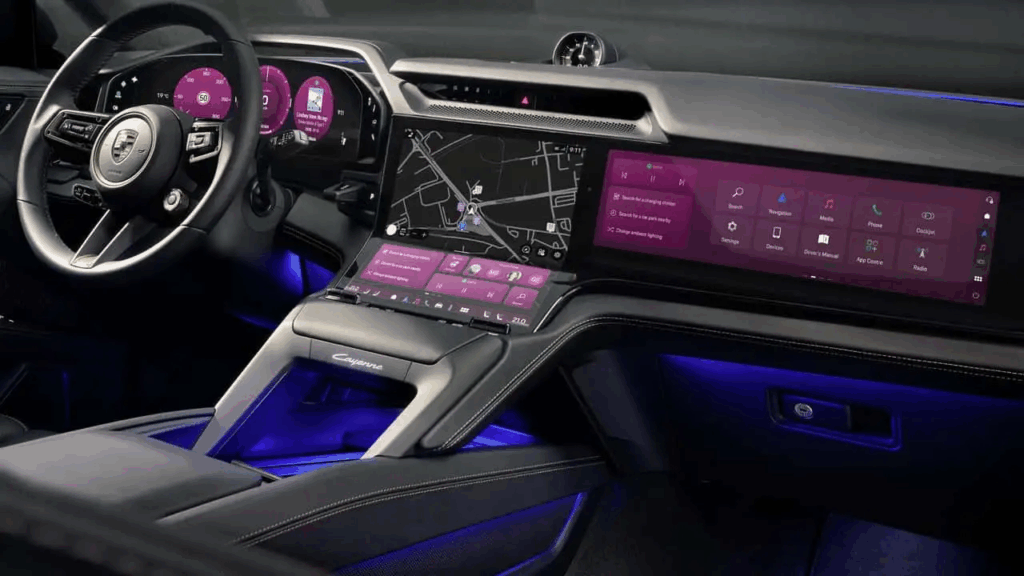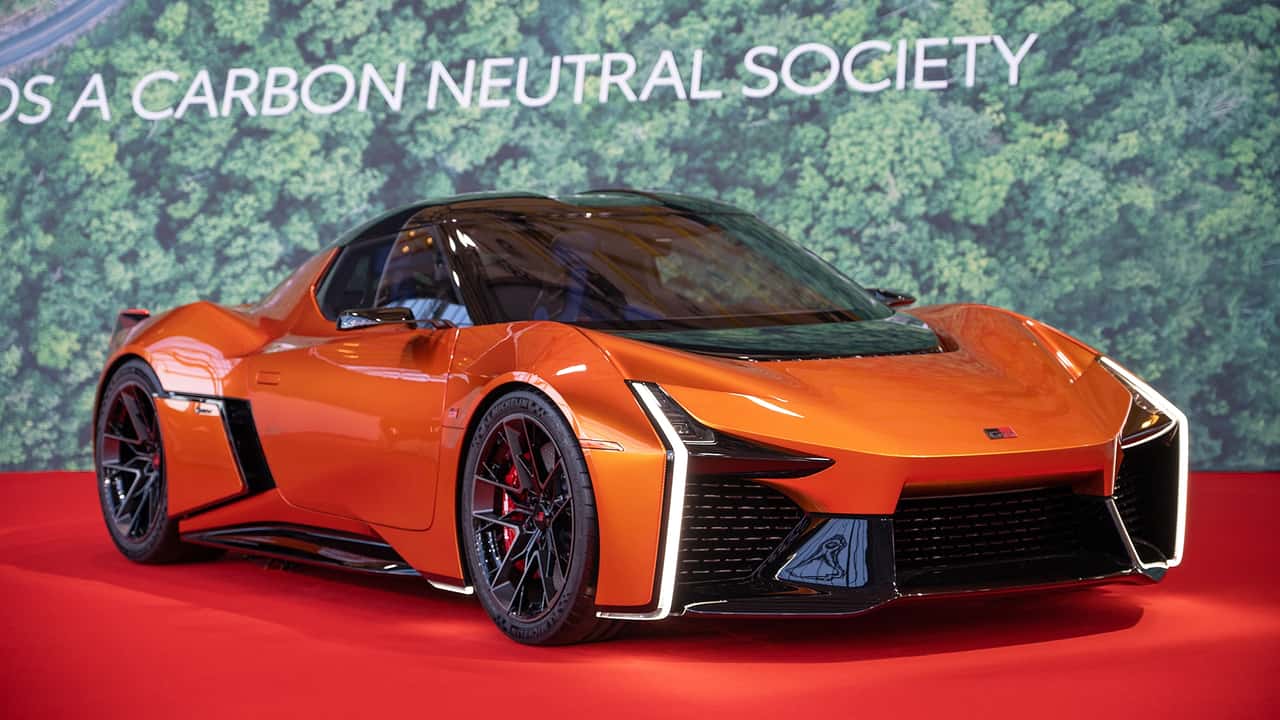The Porsche Cayenne Electric’s Interior Is an Ode to Screens
The curved infotainment looks like a gigantic flip phone.
Porsche’s recent decision to reinvest in combustion engines shows that EV adoption isn’t progressing as quickly as Zuffenhausen had hoped. Even so, the renewed focus on traditional drivetrains isn’t derailing plans for an electric Cayenne. It’s still on track for a reveal later this year, and in the meantime, we’re getting an early look inside the cabin.
Because it’s 2025 and screens dominate interiors, the Cayenne Electric features the “largest display area of any Porsche to date.” The 14.25-inch digital instrument cluster and optional 14.9-inch passenger screen flank a so-called “Flow Display.” This curved 12.25-inch OLED extends down the center console and houses most of the climate controls. A few physical switches remain, though far fewer than in the combustion-powered Cayenne.

Unlike the Taycan, with its separate central screens, the Cayenne Electric merges them into a single unit, creating the impression of a supersized flip phone. A hand rest sits in front of the sweeping display, making it easier to use both the lower portion of the screen and the adjacent switches. The central air vent has been relocated to the top of the dashboard to accommodate the unified display.
Elsewhere, higher trims of the gas-free Cayenne feature heated armrests for both the front and rear doors, as well as a heated center console cover. Porsche will also offer its largest-ever panoramic glass roof, split into nine segments that can individually switch from opaque to clear at the touch of a button. Unlike most glass roofs, this one still opens at the front, like a conventional sunroof.

Beyond the interior, Porsche is also teasing some juicy preliminary specs. The top version with launch control is going to have more than 1,073 horsepower and a staggering 1,106 pound-feet (1,500 Newton-meters) of torque. For such a large and undoubtedly heavy SUV, performance is impressive: 0-62 mph (100 km/h) in under three seconds, 0-124 mph (200 km/h) in under eight seconds, and a top speed exceeding 155 mph (250 km/h).
The battery is a 113-kWh lithium-ion pack with seven percent higher energy density than the Taycan’s. On a full charge, the range is estimated at more than 373 miles (600 km) under the WLTP cycle. With 400-kW charging, a 10-80 percent recharge takes around 15 minutes. For those who’d rather skip cables, an 11-kW wireless charging pad will debut in Europe in 2026 before expanding to other markets.
Porsche Cayenne Electric (Technical Workshop)
141
Source: Porsche
The Cayenne Electric gets sophisticated tech like standard air suspension and optional rear-wheel steering to reduce the turning circle by one meter to about 11.1 meters. At an additional cost, ceramic brakes exclusive to the flagship version feature massive 440-mm front and 410-mm rear discs. The range topper also gets a standard electronically controlled differential lock at the rear. The self-leveling Active Ride system already found in the Panamera and Taycan will be offered as well.
For gas engine traditionalists, the Cayenne Electric’s debut doesn’t spell the end for combustion-powered versions. Porsche plans to keep the ICE Cayenne well into the next decade. The strategy mirrors that of its other SUVs: the electric Macan will coexist with a new gas-powered crossover due in 2028, and a three-row SUV originally envisioned as an EV-only model will launch first with combustion engines before an electric version arrives.
Toyota Planning a New Sports Car Without Anyone’s Help
A GR-branded car independently developed by Toyota is coming… eventually.

By: Adrian Padeanu
Sep 30, at 4:18am ET
Share
Comment
Developing a dedicated sports car is no easy task. Automakers must engineer bespoke parts for a model that won’t sell in large numbers. Without the ability to spread costs by sharing components with mainstream cars and SUVs, achieving economies of scale becomes nearly impossible. Slapping on a high price tag to recoup the investment risks alienating buyers in an already fragile niche.
Accountants would argue that the math rarely works in a sports car’s favor. The solution? A joint effort to build twinned cars and sell enough units for the financials to make sense. Toyota is no stranger to partnerships, having teamed up with Subaru for the GR86/BRZ and with BMW for the Supra/Z4. But can the world’s largest car company really go solo on such a risky endeavor?
Apparently, yes. Sean Hanley, sales and marketing boss at Toyota Australia, told Drive magazine the company has what it takes to develop a performance vehicle independently. Asked whether a GR dedicated sports car will ever be created entirely in-house, his response was crystal clear: “Yes, yes, and yes. You’ll have to wait and see.”
Hanley likely wasn’t referring to the LFR, since the supercar is expected to be a Lexus product without GR branding. Toyota has teased the return of the Celica, though no prototypes have surfaced. The electric FT-Se concept, pictured above, is still slated for launch sometime after 2026. Meanwhile, the Supra bows out next year, but Toyota has promised the iconic name will return.

There have even been rumors of an entry-level GR sports car positioned below the 86. Remember the S-FR? That tiny concept debuted a decade ago, and while it never reached production, Japanese reports continue to hint at an affordable performance car on the way. Still, it’s hard to imagine Toyota launching so many GR products. It’s simply not realistic in an SUV-dominated era to sell multiple sports cars and still turn a profit.
That doesn’t mean the future will be dull. Toyota’s new turbocharged 2.0-liter gasoline engine, showcased in the midship Yaris concept, could serve as the backbone of the GR lineup. This four-cylinder has been engineered for both longitudinal and transverse applications, making it adaptable for front- and mid-engined vehicles. At the higher end, with twice the cylinder count, the Lexus LFR is rumored to feature a V-8 with some form of electrification.
While bespoke GR cars are tough to justify financially, Toyota has an easier case with the GR Yaris and GR Corolla. Their regular counterparts are immensely popular worldwide, laying the groundwork for performance variants. Developing GR versions isn’t prohibitively expensive since they aren’t clean-sheet designs, and Toyota can amortize costs thanks to the success of the mainstream Yaris and Corolla. Another GR built on an existing model could be a large SUV, with Gazoo Racing chief Tomoya Takahashi calling it a “necessity.”



